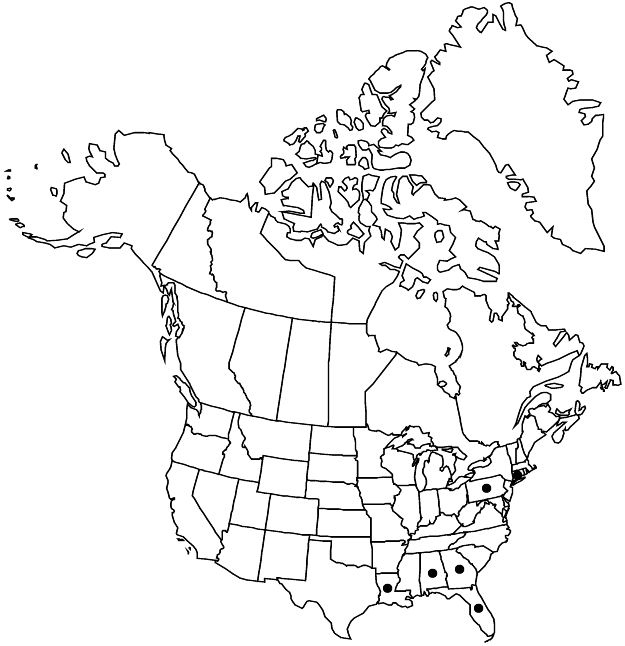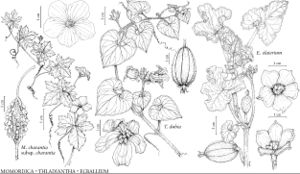Momordica charantia subsp. charantia
Stems glabrous or hairy. Leaves: petiole 1.5–3.5(–6) cm; blade suborbiculate to orbiculate, deeply palmately 5–7-lobed, 5–10(–12) cm, base cordate, lobes ovate-oblong or ovate-elliptic, sinuses 50–90% to base, margins coarsely and widely dentate to crenate-dentate, leaf lobes and teeth sometimes submucronate, not apiculate, surfaces glabrous or sparsely hairy. Inflorescences: staminate peduncles bracteate at or proximal to middle, bracts sessile, reniform or orbiculate-cordate, margins entire; pistillate peduncles ebracteate. Petals bright yellow, obovate to oblong-obovate, 7–25 mm. Fruits red or orange to yellow-orange, cylindric or ellipsoidal to oblong-fusiform or ovoid, 7–25 cm, beak becoming less prominent at maturity, surface usually minutely tuberculate to muricate and muriculate, sometimes irregularly smooth-ridged. Seeds oblong, 10–15 mm. 2n = 22.
Phenology: Flowering Apr–Nov.
Habitat: Disturbed areas, roadsides, fencerows, thickets, hammock edges, fields, ditches, canal banks, shell mounds, orange groves, sand pine scrub, flatwoods, floodplain woods
Elevation: 10–200 m
Distribution

Ala., Conn., Fla., Ga., La., Pa., Africa, introduced also in Mexico, West Indies, South America, Europe, se Asia, Pacific Islands, Australia.
Discussion
No documentation has been found for a report of Momordica charantia in Texas. The species is apparently becoming common in Florida, where it is known to be naturalized in many counties. It is grown as a crop in many countries for the young fruits, which are edible before an extreme bitterness develops in the mature fruits.
Two forms of Momordica charantia in the New World can be distinguished: the ubiquitous weed of the humid lowland tropics and subtropics, growing spontaneously and not cultivated or eaten except occasionally and opportunistically for the pulp; and the domesticated forms, which are seen in Asian markets. The cultivated forms do not escape (M. Nee, pers. comm.).
Momordica charantia subsp. macroloba Achigan-Dako & Blattner is endemic to the Dahomey Gap and Sudano-Guinean phytoregion of Benin and Togo in west-central Africa.
Selected References
None.
